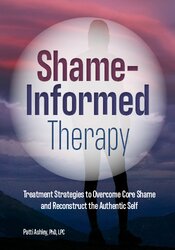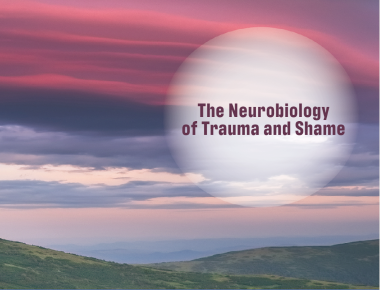The Neurobiology of Trauma and Shame
Uncovering Shame-Based Beliefs

When we work with shame in clinical practice, trauma-informed practices are often helpful, as the neurobiology of shame looks very similar to trauma in the body. Explicit trauma often coincides with implicit shame, and both impact the ability to feel emotionally safe and return to a ventral vagal state. The important part to think about when looking at core shame is how it gets imprinted in the nervous system with early attachment experiences during the nonverbal stage of development. Repeated ruptures in interpersonal bridges during childhood result in a lowered capacity for right-left brain integration and nervous system regulation into a ventral vagal state.
When situations of shame and trauma continually disrupt activation of the ventral vagal complex, long-term access to the social engagement system decreases, which impacts future relationships. Traumatized individuals carry the disorganized and disrupted states in the body memory, which then keeps the trauma alive (Ogden, 2003). Since there is no time in body memory, activating a trauma or shame state can feel as if it is happening in that moment. In turn, clients may engage in a variety of defensive behaviors that reflect their primitive survival instinct. They may strike out in anger, go into a state of immobilization, or engage in other maladaptive coping patterns. Overriding these survival instincts requires retraining the body memory to feel safe.
To help clients regain this sense of safety and return the body to a ventral vagal state, Stephen Porges suggests using the four therapeutic R鈥檚 when working with trauma and shame: Recognizing the autonomic state the client is in, Respecting the adaptive survival response, Regulating or co-regulating with the client into a ventral vagal state, and then Re-storying (Porges, 2009). When the clinician is aware of these four R鈥檚 in treating shame, the therapeutic dance becomes one of co-regulation and safety. Since shame often hides underground, the clinician needs a very fine level of discrimination while investigating the underlying dysregulated shame states. You can find an in-depth discussion of each of therapeutic R鈥檚 in chapters 4 through 8 of my new book, Shame-Informed Therapy: Treatment Strategies to Overcome Core Shame and Reconstruct the Authentic Self.
In the meantime, you can try the following Excavation Exercise with clients to begin addressing some of their core feelings surrounding not feeling good enough. This worksheet is a practical tool you can use to identify unconscious shame beliefs, whether or not you used the word shame in session yet. So often, clients have been talked out of their feelings and are unable to access what they are experiencing. First and foremost, we want the client to excavate the parts of the self that they may have hidden under their core shame identity. Here we begin the process of re-storying by remembering and reconstructing what the client may have buried in the past.
*
This is an excerpt from Shame-Informed Therapy by Patti Ashley. Copyright 漏 2020, Patti Ashley. 小蝌蚪视频 Publishing & Media
When situations of shame and trauma continually disrupt activation of the ventral vagal complex, long-term access to the social engagement system decreases, which impacts future relationships. Traumatized individuals carry the disorganized and disrupted states in the body memory, which then keeps the trauma alive (Ogden, 2003). Since there is no time in body memory, activating a trauma or shame state can feel as if it is happening in that moment. In turn, clients may engage in a variety of defensive behaviors that reflect their primitive survival instinct. They may strike out in anger, go into a state of immobilization, or engage in other maladaptive coping patterns. Overriding these survival instincts requires retraining the body memory to feel safe.
To help clients regain this sense of safety and return the body to a ventral vagal state, Stephen Porges suggests using the four therapeutic R鈥檚 when working with trauma and shame: Recognizing the autonomic state the client is in, Respecting the adaptive survival response, Regulating or co-regulating with the client into a ventral vagal state, and then Re-storying (Porges, 2009). When the clinician is aware of these four R鈥檚 in treating shame, the therapeutic dance becomes one of co-regulation and safety. Since shame often hides underground, the clinician needs a very fine level of discrimination while investigating the underlying dysregulated shame states. You can find an in-depth discussion of each of therapeutic R鈥檚 in chapters 4 through 8 of my new book, Shame-Informed Therapy: Treatment Strategies to Overcome Core Shame and Reconstruct the Authentic Self.
In the meantime, you can try the following Excavation Exercise with clients to begin addressing some of their core feelings surrounding not feeling good enough. This worksheet is a practical tool you can use to identify unconscious shame beliefs, whether or not you used the word shame in session yet. So often, clients have been talked out of their feelings and are unable to access what they are experiencing. First and foremost, we want the client to excavate the parts of the self that they may have hidden under their core shame identity. Here we begin the process of re-storying by remembering and reconstructing what the client may have buried in the past.
*
This is an excerpt from Shame-Informed Therapy by Patti Ashley. Copyright 漏 2020, Patti Ashley. 小蝌蚪视频 Publishing & Media
Help clients excavate the parts of themselves that have been hidden under their core shame identity...

The tools in this book will allow you to work together with your clients to create and embody a new story of self-love and compassion鈥攁 story that is more congruent with their authentic self.



